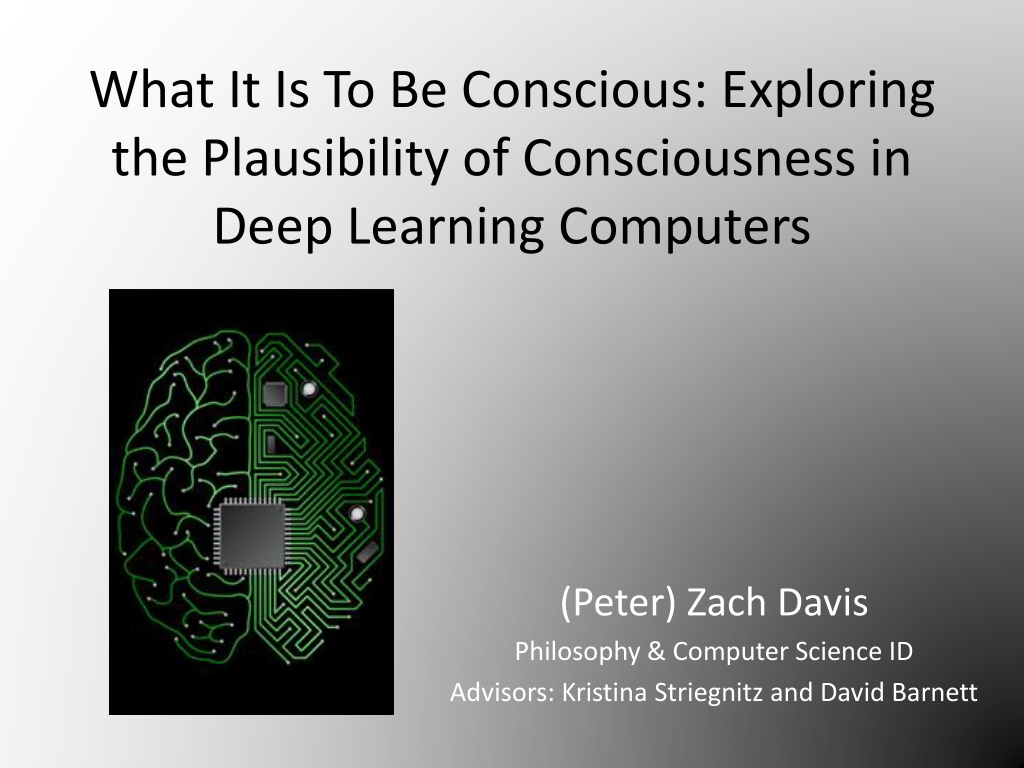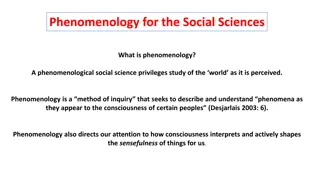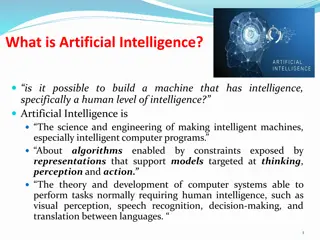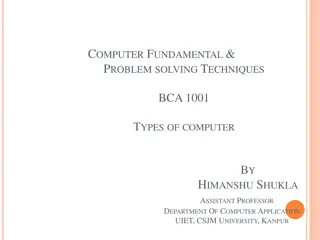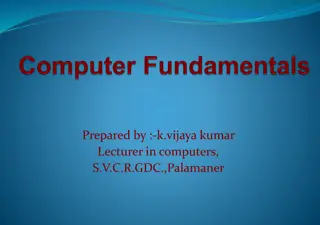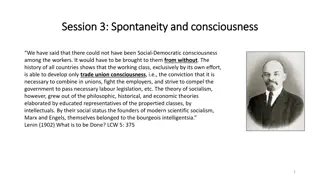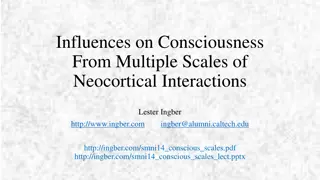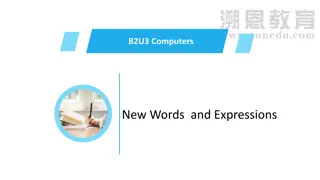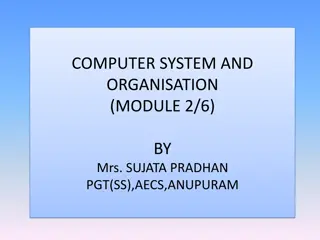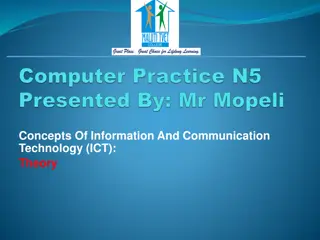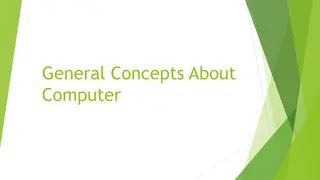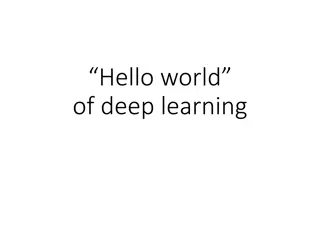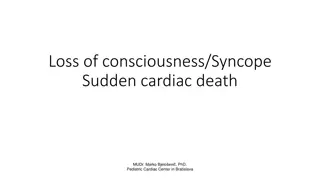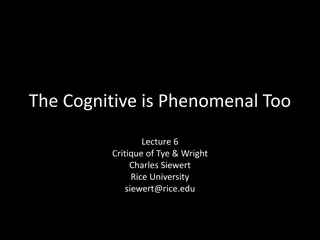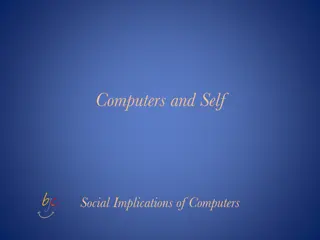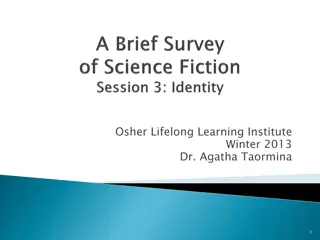Exploring Consciousness in Deep Learning Computers
Delve into the plausibility of consciousness in deep learning computers through the lens of artificial neural networks and machine learning. While these technologies offer remarkable potential, the debate around their consciousness remains inconclusive.
Uploaded on Sep 24, 2024 | 0 Views
Download Presentation

Please find below an Image/Link to download the presentation.
The content on the website is provided AS IS for your information and personal use only. It may not be sold, licensed, or shared on other websites without obtaining consent from the author. Download presentation by click this link. If you encounter any issues during the download, it is possible that the publisher has removed the file from their server.
E N D
Presentation Transcript
What It Is To Be Conscious: Exploring the Plausibility of Consciousness in Deep Learning Computers (Peter) Zach Davis Philosophy & Computer Science ID Advisors: Kristina Striegnitz and David Barnett
Motivation Deep learning computers are amazing!
Motivation Deep learning computers are amazing! But No consensus on their consciousness
Machine Learning Derive generalizations from examples
Machine Learning Derive generalizations from examples Similar to humans
Machine Learning Derive generalizations from examples Similar to humans One method uses artificial neural networks
Artificial Neural Networks Single Perceptron General model for neuron
Artificial Neural Networks Single Perceptron General model for neuron Used in: 1. Feed-Forward Neural Networks 2. Recurrent Neural Networks
Artificial Neural Networks Feed-Forward Networks o Most common type o Neural links only go forward oLike an assembly line o Output becomes input for next layer
Artificial Neural Networks Recurrent Networks o More complex o Neural links are bidirectional o Output can be input for: o Next layer o Current layer o Previous layer o Support memory
Deep Learning Type of machine learning Specific structure: Deep (lots of) layers of neural networks Examples: Convolutional Neural Networks Deep Belief Networks
Deep Learning Convolutional Neural Networks Feed-forward network Neurons correspond to overlapping parts of the image Outputs from layers are pooled
Deep Learning Deep Belief Networks Layers learn in top-down approach Layers depend on other layers Can reconstruct inputs Generative model e.g. generate an image
Consciousness (Functionalism) Multiple Drafts Model Daniel Dennett Brain activity is parallel Information is continually revisable and accessible
Consciousness (Functionalism) Multiple Drafts Model Daniel Dennett Brain activity is parallel Information is continually revisable and accessible Qualia don t really exist
Consciousness (Functionalism) Multiple Drafts Model Daniel Dennett Brain activity is parallel Information is continually revisable and accessible Qualia don t really exist Consciousness = the functional effects of judgments
Are Deep Learning Computers Conscious? Multiple Drafts Model Consciousness doesn t need qualia
Are Deep Learning Computers Conscious? Multiple Drafts Model Consciousness doesn t need qualia Deep Learning computers: Function consciously Process information consciously
Are Deep Learning Computers Conscious? Multiple Drafts Model Consciousness doesn t need qualia Deep Learning computers: Function consciously Process information consciously Thus: computers are conscious
Consciousness (Partial Physicalism) Hybrid Theory Ned Block Physicalism: Conscious states = Physical states
Consciousness (Partial Physicalism) Hybrid Theory Ned Block Physicalism: Conscious states = Physical states o Access-consciousness (A-consciousness) states that are available for rational processes o Phenomenal-consciousness (P-consciousness) what it is like-ness
Consciousness (Partial Physicalism) Hybrid Theory Ned Block Physicalism: Conscious states = Physical states o Access-consciousness (A-consciousness) states that are available for rational processes o Phenomenal-consciousness (P-consciousness) what it is like-ness Consciousness refers to A- and P-states Physical make-up matters!
Are Deep Learning Computers Conscious? Hybrid Theory Consciousness -> both A-states and P-states
Are Deep Learning Computers Conscious? Hybrid Theory Consciousness -> both A-states and P-states Deep learning computers aren t P-conscious They don t support P-consciousness
Are Deep Learning Computers Conscious? Hybrid Theory Consciousness -> both A-states and P-states Deep learning computers aren t P-conscious They don t support P-consciousness Thus: computers are unconscious But they are A-conscious
Consciousness (Modified Functionalism) Integrated Information Theory Giulio Tononi Consciousness depends on:
Consciousness (Modified Functionalism) Integrated Information Theory Giulio Tononi Consciousness depends on: Information: number of possible alternative outcomes (based on entropy) Integration: interdependency between parts of the system
Consciousness (Modified Functionalism) Integrated Information Theory Giulio Tononi Consciousness depends on: Information: number of possible alternative outcomes (based on entropy) Integration: interdependency between parts of the system Amount of consciousness relates to 1. Amount of information in the system 2. Degree of interdependency in subsystems
Are Deep Learning Computers Conscious? Integrated Information Theory Consciousness = information integration
Are Deep Learning Computers Conscious? Integrated Information Theory Consciousness = information integration Feed-back is important
Are Deep Learning Computers Conscious? Integrated Information Theory Consciousness = information integration Feed-back is important Thus: Feed-forward networks (convolutional networks) not conscious Recurrent networks (deep belief networks) are conscious *Consciousness varies with design
Where Do We Go From Here? Which theory is correct?
Where Do We Go From Here? Which theory is correct? How do we find out? Philosophical debate Empirical research Consciousness science Neural Network Design
